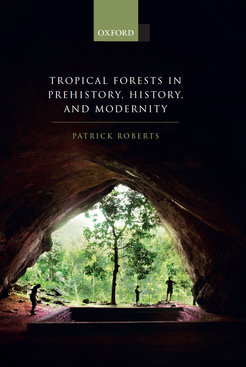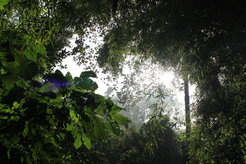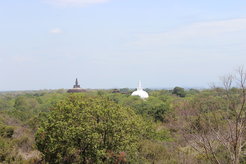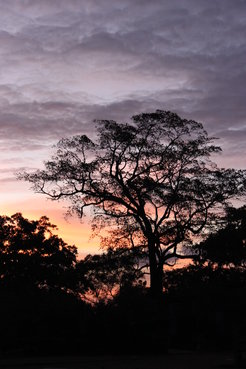New Book ‘Tropical Forests in Prehistory, History, and Modernity’ Reveals Long-Term Human Use and Habitation of Critically Endangered Habitats
This new text is the first to bring together evidence for the nature of human interactions with tropical forests on a global scale, from the emergence of hominins in the tropical forests of Africa to modern conservation issues.
In popular discourse, tropical forests are synonymous with 'nature' and 'wilderness', battlegrounds between apparently pristine floral, faunal, and human communities, and the unrelenting industrial and urban powers of the modern world. Most people are not aware of the extent of human adaptation to, and alteration of, tropical forest environments, and that these interactions have been ongoing across archaeological, historical, and anthropological timescales. The new book was written by Dr Patrick Roberts of the Max Planck Institute for the Science of Human History and published by Oxford University Press on 17 January 2019. The publication emerges from Dr Roberts’ work on projects in the tropics of Asia, Africa, and the Americas, and takes a tour of human, and human ancestor, occupation and use of tropical forest environments through time.

In ‘Tropical Forests in Prehistory, History, and Modernity’, Dr Roberts argues that, far from being pristine ecosystems, tropical forests have been occupied and modified by our species from the earliest stages of our evolution. The text, aimed at a broad audience of students to specialized researchers spanning archaeology, anthropology, history, and ecology, explores the sophisticated agricultural strategies and vast urban networks appeared in tropical forests long prior to the arrival of European colonial powers and later industrialization. However, this should not be taken as justification for the massive 21st century threats facing tropical forest ecosystems. Rather, Roberts argues that such a long-term perspective should highlight the ongoing challenges of sustainability faced by forager, agricultural, and urban societies in these environments, setting the stage for more integrated approaches to conservation and policy-making, and the protection of millennia of ecological and cultural heritage bound up in these habitats.
More complex hominin and human origins
Since Darwin wrote the Descent of Man in 1871, tropical forests, and their non-human ape inhabitants, have often been perceived as being left behind by hominins as they gained increasingly ‘human’ traits of tool use, medium-large game hunting, and upright locomotion in open savannas. However, there is growing evidence for complexity in this trend. In this new book, Roberts argues that morphological, palaeoenvironmental, and palaeodietary evidence highlights the persistent use of tropical forests, exemplifying the habitat variability between 7 and 3 million years ago that may have ultimately driven the evolution of our genus (Homo) towards the end of this period.
Similarly, the evolution and dispersal of our own species, Homo sapiens, has frequently been linked to grassland settings or productive coastal environments. Meanwhile, tropical forests have often been seen as barriers to human dispersal. In contrast, Roberts argues that evidence in tropical forests from around the world demonstrates that our species rapidly colonized these habitats. This adds to data from other ‘extreme’ habitats, such as deserts, high altitude habitats, and the palaeoarctic, that highlight the unique ecological and cultural plasticity of our species as it colonized the Late Pleistocene world and came to be the last hominin standing.
Taming the tropics

Not only did our species adapt to tropical forests, but there is also growing data that hunter-gatherers managed tropical forests from as early as 45,000 years ago, using fire to create local, mixed habitats with abundant useful plant and animal species. Nevertheless, discussions of ‘agriculture’ in archaeology have tended to focus on dry, grassland settings, such as those found in the Middle East. Tropical forests, by contrast, have been argued to have soils that are too poor or vulnerable for farming, and that they lacked animals suitable for domestication.
Roberts reviews evidence from around the world to show how this perspective has been overturned. For example, the tending of yams, bananas, and taro in Early Holocene New Guinea represents one of the earliest archaeological examples of farming. Furthermore, research in South Asia, Southeast Asia, Africa, and the Neotropics reveals that a diversity of plants and animals, including maize, chicken, water buffalo, mango, black pepper, and sweet potato, which are crucial to global cuisine and subsistence today, likely or definitely originated in tropical forest settings.

“In reviewing prehistoric evidence for tropical agriculture we can, however, see a clear difference in the ultimate ecological impact of ‘indigenous’ tropical forest agriculture, based on local tropical plants and animals, versus the introduction of ‘external’ farming practices”, states Roberts. This is still visible in the modern world as ‘plantation’ agriculture or ‘ranching’ results in reductions in local tropical biodiversity, soil erosion, and deforestation.
‘Lost cities’ or legacies of sustainability?
Not only does the evidence reviewed in the book document clear cases of prehistoric agriculture in tropical forests, but there is also growing data that these forms of food production supported vast urban cities. New techniques and survey, notably those using canopy-penetrating Light Detection and Ranging (LiDAR), have revealed human settlement in the Americas and Southeast Asia on a scale that was previously unimagined.

“In many cases these cities show a tendency towards ‘low density agrarian urbanism’, whereby agricultural fields, orchards, and households are dispersed around a bureaucratic centre”, says Roberts. This organization contributed to the resilience of these settlements that in some cases clearly persisted many times longer than more recent industrial and urban settlements of the modern world have so far been present in these environments. The largest, Greater Angkor, was the most extensive pre-industrial urban sprawl ever recorded.
The evidence reviewed in the book highlights that these dispersed urban settlements were most successful where they utilized a diversity of wild and domesticated resources. For example, in the Amazon, ‘Garden Cities’ made consistent use of freshwater fish and even farmed turtles, while the populations living within Classic Maya cities corralled wild deer and used semi-wild orchards while also relying on maize farmed in forest ‘gardens’ rather than monoculture plantations. Such cases give pause for thought for tropical urban centres today that often rely on monoculture or dense rearing conditions for domesticated animals.
Uniting prehistory, history, and the present
Beyond archaeology, the book seeks to take a multidisciplinary perspective to appeal to a wide range of research backgrounds and interests. For example, Dr Roberts’ uses history and ethnography to critique western perspectives of Indigenous people living in tropical forests today, who are often considered ‘isolated’ or ‘untouched’, and passive in the face of the expansion of global industry and trade. Roberts argues that these groups are often active agents, and have engaged in some of the most successful instances of combining global capitalism with the needs and demands of local tropical forest ecosystems. As such they must be included in any discussion of sustainable conservation, development, and policy, rather than be treated as passive entities to be protected or relocated.

The book also reviews the practical ways in which archaeology can contribute to conservation in tropical forest ecosystems today. This includes evaluation of ‘re-wilding’ opportunities for specific plants and animals, the reconstruction of past environmental change to aid future predictions, and to highlight the social, cultural, and ecological constraints that have faced different types of social organization and types of tropical forest environment in the past.
Tropical forests are central to earth systems today, with local deforestation potentially having global ramifications. Long-term evidence for human interactions with these environments does not give a free pass for their destruction today, particularly as global capitalism ensures major ecosystem destruction can be driven by consumers on the other side of the planet. Instead, we should try to use the past, as well as the knowledge held by various local stakeholders, to develop methods for sustainable modification of different tropical forests ensuring, as Roberts states, “that the oldest terrestrial environments on our planet continue to stand as crucial time capsules of cultural and ecological heritage for future generations”.




